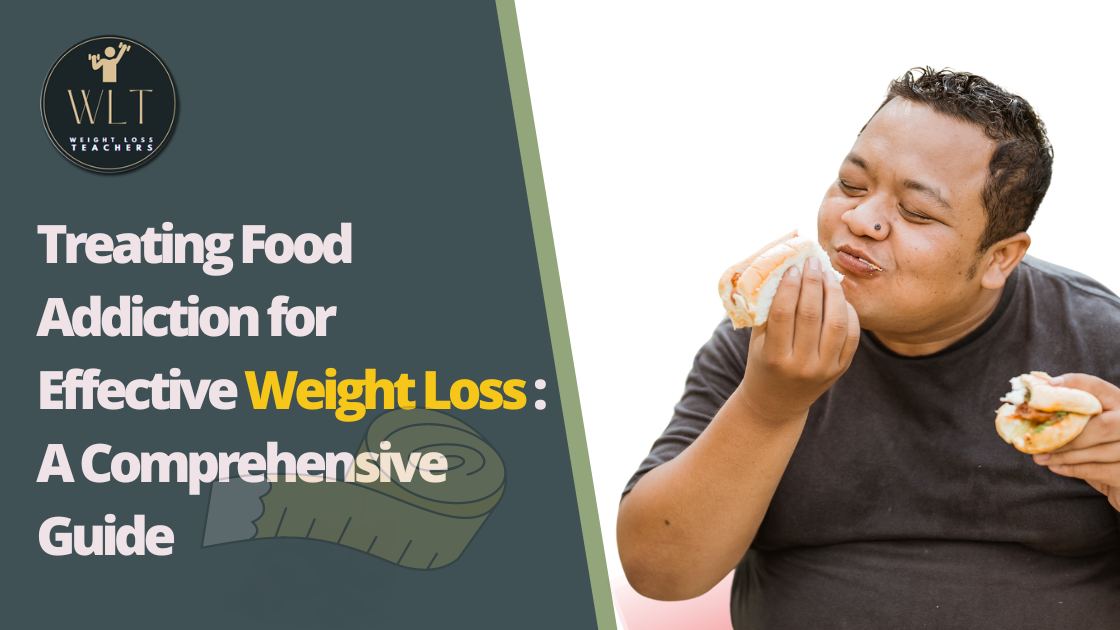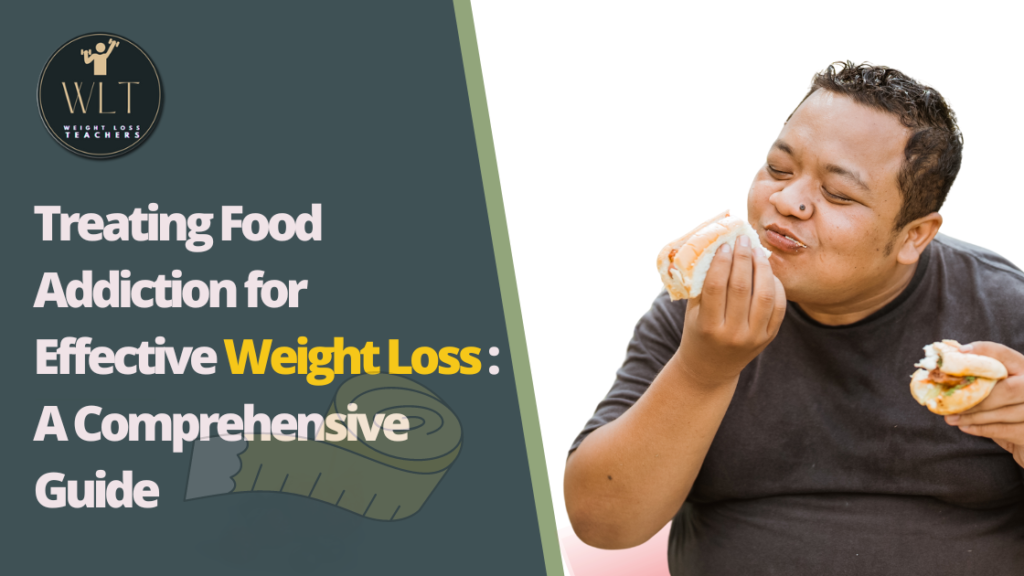
Treating Food Addiction for Effective Weight Loss: A Comprehensive Guide

In today’s fast-paced society, the prevalence of food addiction has increased significantly, leading to detrimental effects on health, particularly in relation to weight gain and obesity.
Table of Contents
Introduction
Food addiction is a complex condition characterized by an uncontrollable craving for certain foods, loss of control over eating behaviors, and persistent overconsumption, often resulting in weight-related problems. This comprehensive guide aims to explore effective strategies and interventions to treat food addiction, promoting sustainable weight loss and improved overall well-being.

Understanding Food Addiction

2.1 Definition of Food Addiction:
Food addiction can be defined as a compulsive relationship with food that resembles substance addiction. It involves a loss of control over eating behaviors, persistent cravings for specific foods (often high in sugar, fat, or salt), and continued consumption despite negative consequences on physical and mental health. Food addiction shares similarities with other addictive disorders, such as drug or alcohol addiction, in terms of neurobiological processes and behavioral patterns. However, unlike substance addictions, individuals with food addiction must learn to manage their relationship with food while still meeting their essential nutritional needs.
2.2 Signs and Symptoms of Food Addiction:
Recognizing the signs and symptoms of food addiction is crucial for early intervention and treatment. Common indicators include:
- Preoccupation with food: Constant thoughts about food, planning meals excessively, or obsessively thinking about the next opportunity to eat.
- Loss of control: Difficulty stopping or controlling the amount of food consumed, even when feeling physically full or experiencing negative consequences.
- Cravings and intense urges: Strong, uncontrollable desires for specific types of food, often highly processed or rich in sugar, fat, or salt.
- Emotional eating: Turning to food for comfort, stress relief, or as a coping mechanism for negative emotions.
- Withdrawal symptoms: Experiencing irritability, mood swings, or physical discomfort when attempting to cut down or eliminate certain foods.
- Social withdrawal and shame: Avoiding social situations involving food due to fear of losing control or feelings of guilt and shame related to overeating
The Relationship between Food Addiction and Weight Gain

3.1 The Role of Reward Pathways:
Food addiction is closely linked to the brain’s reward system, which involves the release of dopamine—a neurotransmitter associated with pleasure and reward. Highly palatable and processed foods, rich in sugar, fat, and salt, can trigger an exaggerated release of dopamine, leading to a heightened sense of pleasure and reinforcing the desire for more of these foods. Over time, this can result in desensitization of the brain’s reward pathways, requiring larger quantities of food to achieve the same level of satisfaction. Consequently, individuals with food addiction may consume excessive amounts of food, leading to weight gain and an increased risk of obesity.
3.2 Psychological Factors:
Psychological factors play a significant role in the development and perpetuation of food addiction. Stress, for instance, can trigger overeating as a means of coping, leading to the release of “feel-good” neurotransmitters that temporarily alleviate negative emotions. Emotional eating, often driven by sadness, loneliness, or boredom, can create a cycle of using food as a source of comfort. Moreover, body image dissatisfaction and societal pressures to attain a certain weight or appearance can contribute to disordered eating behaviors, including food addiction.
Treating Food Addiction for Weight Loss

4.1 Diagnostic Assessment and Evaluation:
Accurate diagnosis and assessment of food addiction are vital for effective treatment. Healthcare professionals may use various screening tools and questionnaires to evaluate the severity of food addiction and its impact on an individual’s physical and mental well-being. Assessments may include an examination of eating behaviors, psychological symptoms, and medical history. A comprehensive evaluation helps tailor treatment plans to the specific needs of the individual, ensuring the most appropriate interventions are employed.
4.2 Cognitive-Behavioral Therapy (CBT):
Cognitive-Behavioral Therapy (CBT) is a widely used approach for treating food addiction. CBT aims to identify and modify maladaptive thoughts and behaviors related to food, promote self-awareness, and develop healthier coping mechanisms. Through techniques such as self-monitoring, cognitive restructuring, and behavioral experiments, individuals can challenge their negative beliefs about food, learn to recognize triggers for overeating, and develop strategies to manage cravings effectively.
4.3 Mindfulness and Meditation:
Mindfulness-based interventions have shown promise in treating food addiction by enhancing self-regulation and reducing impulsive eating behaviors. Mindfulness involves paying non-judgmental attention to the present moment, including thoughts, feelings, and bodily sensations. By cultivating a mindful eating practice, individuals can develop a greater awareness of hunger and fullness cues, engage in conscious food choices, and increase satisfaction from smaller portions. Meditation techniques, such as body scans and mindful breathing, can further support stress reduction and emotional well-being, diminishing the reliance on food as a coping mechanism.
4.4 Nutritional Counseling:
Nutritional counseling plays a vital role in managing food addiction and promoting weight loss. Registered dietitians can help individuals develop balanced meal plans, identify trigger foods, and provide education on the nutritional value of various food choices. They may emphasize the importance of consuming whole, nutrient-dense foods while addressing specific dietary needs and preferences. Nutritional counseling can also involve strategies for overcoming food cravings, such as mindful eating techniques, portion control, and incorporating satisfying alternatives into the diet.
4.5 Support Groups and Peer Support:
Engaging in support groups or seeking peer support is a valuable component of the recovery process from food addiction. Connecting with individuals who have had similar experiences provides a sense of belonging and understanding, reducing feelings of isolation and shame. Support groups may offer a platform to share challenges, successes, and strategies for maintaining recovery. Online communities and forums can provide a convenient and accessible way to connect with others, exchange resources, and receive encouragement throughout the journey.
4.6 Pharmacotherapy:
In some cases, pharmacotherapy may be considered as an adjunct to behavioral interventions for food addiction. Medications such as naltrexone, topiramate, or bupropion may be prescribed to help reduce cravings, modify reward pathways, and support the management of underlying psychological factors. However, pharmacotherapy should always be administered under medical supervision, and the potential benefits and risks should be carefully evaluated on an individual basis.
Note: There might be affiliate links mentioned here. We may receive a commission if you purchase a product through an affiliate link. There is no additional charge for you. Please do your own research before making any online purchases.
Implementing Long-Term Lifestyle Changes

5.1 Physical Activity and Exercise
Regular physical activity and exercise play a pivotal role in both weight management and addiction recovery. Beyond the obvious benefits of burning calories and supporting weight loss efforts, exercise has a profound impact on mental well-being. When individuals engage in physical activities, the body releases endorphins, often referred to as “feel-good” hormones. These endorphins can significantly improve mood and reduce cravings, which is particularly beneficial for those in addiction recovery.
One of the keys to long-term adherence to an exercise routine is finding activities that bring joy and align with individual preferences and physical abilities. When exercise is enjoyable, it becomes less of a chore and more of a rewarding experience. It could be anything from dancing, hiking, cycling, swimming, or practicing a sport. Additionally, incorporating variety into the routine can keep things interesting and prevent boredom, making it more likely for individuals to stick with it over time.
By incorporating physical activity into their daily lives, individuals not only enhance their overall health and well-being but also create a positive outlet for managing stress and emotions, ultimately supporting their journey towards a healthier relationship with food and their bodies.
5.2 Stress Management Techniques:
Stress management techniques are indispensable tools for preventing emotional eating and effectively managing food addiction. Stress can be a significant trigger for turning to food as a coping mechanism, leading to unhealthy eating behaviors. By incorporating stress reduction practices into their daily routine, individuals can cultivate healthier ways of dealing with difficult emotions.
Deep breathing exercises, for instance, are simple yet powerful techniques to reduce stress and anxiety. By focusing on slow, deep breaths, the body’s stress response is diminished, promoting a sense of calmness and relaxation.
Progressive muscle relaxation is another effective method for releasing tension and stress from the body. It involves tensing and relaxing different muscle groups to promote physical and mental relaxation.
Yoga and meditation have also shown to be beneficial in reducing stress levels and promoting mindfulness. These practices encourage individuals to be present in the moment, which can help break the cycle of emotional eating and bring awareness to one’s feelings and behaviors around food.
Implementing stress management techniques not only helps in managing food addiction but also positively impacts overall well-being. By learning healthier coping mechanisms, individuals can navigate challenges without resorting to unhealthy eating habits, thus supporting sustainable weight loss efforts and promoting a more balanced relationship with food.
5.3 Sleep Hygiene:
Sleep hygiene refers to the set of practices and habits that promote healthy sleep patterns. Establishing good sleep hygiene is essential for managing food addiction, as poor sleep quality or insufficient sleep can disrupt hormonal balance and negatively affect appetite regulation.
Prioritizing adequate sleep duration is crucial for individuals in addiction recovery, as it helps regulate appetite hormones like ghrelin and leptin, which play a role in hunger and satiety. When these hormones are imbalanced due to inadequate sleep, it can lead to overeating and unhealthy food choices.
Practicing good sleep hygiene involves maintaining a consistent sleep schedule, going to bed and waking up at the same time each day. This routine helps regulate the body’s internal clock, making it easier to fall asleep and wake up naturally.
Creating a conducive sleep environment is also essential for promoting restful sleep. This may include keeping the bedroom cool, dark, and quiet, investing in a comfortable mattress and pillows, and limiting screen time before bedtime to avoid disturbances from electronic devices.
Incorporating relaxation techniques before bedtime can help individuals unwind and prepare their minds and bodies for sleep. Practices such as reading, taking a warm bath, or practicing mindfulness can be beneficial in promoting relaxation and improving sleep quality.
By prioritizing sleep hygiene, individuals can improve their sleep quality, which in turn positively influences their eating behaviors. Adequate and restful sleep supports overall well-being and enhances an individual’s ability to manage food addiction effectively.
Maintaining Recovery and Preventing Relapse

6.1 Self-Monitoring and Goal Setting
Self-monitoring is a fundamental aspect of eating disorder recovery that involves keeping track of various aspects of one’s journey. This process goes beyond simply monitoring food intake; it also includes tracking emotions, triggers, and progress towards recovery goals. By consistently monitoring their behaviors and emotional responses, individuals can gain valuable insights into patterns and tendencies that may have contributed to their eating disorder. Self-monitoring helps create a heightened awareness of these behaviors and emotions, allowing individuals to recognize when they are falling back into old habits and enabling them to take proactive steps to avoid relapse.
Goal setting is another crucial component of the recovery process. Establishing realistic and achievable goals, both short-term and long-term, provides individuals with a sense of purpose and direction. Short-term goals allow for incremental progress, building confidence and motivation along the way. Long-term goals, on the other hand, offer a bigger vision and a reason to stay committed to recovery even during challenging times.
Regularly evaluating progress is essential in ensuring that individuals stay on track with their recovery journey. By measuring their advancement against set goals, they can celebrate successes, identify areas that need improvement, and make necessary adjustments to their strategies. This ongoing assessment serves as a powerful source of motivation, reinforcing the determination to overcome the disorder.
Furthermore, the process of goal setting and self-monitoring can be empowering for individuals in recovery. It shifts the focus from feeling powerless over the eating disorder to actively taking charge of one’s life and health. This sense of agency is a crucial aspect of healing and building a positive relationship with oneself.
Overall, self-monitoring and goal setting are two complementary practices that reinforce each other. The act of monitoring behaviors and emotions creates valuable data for setting realistic goals, while goal setting gives purpose and direction to the self-monitoring process. By integrating these practices into their daily lives, individuals can cultivate resilience and sustain their progress towards recovery.
6.2 Relapse Prevention Strategies
In the journey of eating disorder recovery, developing effective relapse prevention strategies is paramount to maintaining long-term progress and minimizing the risk of setbacks. While relapses can be disheartening, they are also opportunities for learning and growth. Implementing well-thought-out strategies can significantly increase an individual’s ability to navigate challenging situations and cope with triggers effectively.
Identifying high-risk situations is a crucial first step in relapse prevention. By recognizing situations or environments that may trigger disordered eating behaviors, individuals can develop strategies to avoid or manage them proactively. This may involve steering clear of specific triggers or learning coping mechanisms to navigate these situations more healthily.
Building coping skills is an essential aspect of relapse prevention. This involves equipping individuals with alternative ways to deal with stress, anxiety, and negative emotions. Therapeutic techniques like cognitive-behavioral therapy (CBT) and dialectical behavior therapy (DBT) can be valuable tools in developing effective coping strategies. These techniques can help replace harmful behaviors with healthier ones, fostering resilience in the face of adversity.
Creating a robust support network is equally vital in maintaining long-term recovery. Surrounding oneself with understanding and empathetic individuals, such as friends, family, or support groups, can provide encouragement, validation, and a sense of belonging. Having people to turn to during challenging times can be immensely helpful in preventing relapse and staying motivated on the path to recovery.
Practicing self-care is an often underestimated but powerful aspect of relapse prevention. Engaging in activities that promote physical, emotional, and mental well-being can significantly contribute to overall stability and resilience. Regular exercise, sufficient sleep, balanced nutrition, and engaging in hobbies or creative outlets can all play a role in reducing stress and improving mood.
Despite the best efforts, relapses may still occur. In such instances, it is crucial to approach them without self-judgment. Instead of viewing relapses as failures, individuals can learn from them and gain insight into triggers and vulnerabilities. Utilizing setbacks as opportunities for growth and further self-understanding can lead to increased resilience and strengthen one’s commitment to recovery.
Lastly, recognizing when professional help is needed and seeking it promptly is essential. Therapists, counselors, or support groups specializing in eating disorders can provide tailored guidance and assistance, helping individuals overcome challenges and maintain steady progress.
FAQs (Frequently Asked Questions)
Q1: What is food addiction, and how does it differ from other addictive disorders?
A1: Food addiction is a condition characterized by an uncontrollable craving for certain foods, loss of control over eating behaviors, and persistent overconsumption. It differs from other addictive disorders in that individuals must learn to manage their relationship with food while still meeting their nutritional needs.
Q2: What are the signs and symptoms of food addiction?
A2: Common signs of food addiction include preoccupation with food, loss of control, cravings, emotional eating, withdrawal symptoms, and social withdrawal and shame related to overeating.
Q3: How does food addiction contribute to weight gain?
A3: Food addiction can lead to weight gain as individuals may consume excessive amounts of food, particularly highly palatable and processed foods. The brain’s reward system and the release of dopamine play a significant role in reinforcing cravings and overeating.
Q4: What is cognitive-behavioral therapy (CBT), and how does it help treat food addiction? A4: CBT is a therapeutic approach that helps individuals identify and modify maladaptive thoughts and behaviors related to food addiction. It assists in developing self-awareness, managing triggers, and learning healthier coping mechanisms.
Q5: Can mindfulness and meditation help with food addiction recovery?
A5: Yes, mindfulness and meditation techniques can be effective in treating food addiction. They promote self-regulation, increase awareness of hunger and fullness cues, and provide alternative ways of coping with stress and emotions.
Q6: How can nutritional counseling assist in managing food addiction?
A6: Nutritional counseling helps individuals develop balanced meal plans, identify trigger foods, and make healthier food choices. It also addresses strategies for overcoming food cravings and supports the adoption of sustainable dietary habits.
Q7: Are there support groups available for individuals struggling with food addiction?
A7: Yes, support groups provide valuable peer support and a sense of community for individuals with food addiction. They offer a platform to share experiences, exchange resources, and receive encouragement throughout the recovery process.
Q8: Is medication used in the treatment of food addiction?
A8: In some cases, medications may be prescribed as an adjunct to behavioral interventions for food addiction. They can help reduce cravings, modify reward pathways, and address underlying psychological factors. However, medication should always be administered under medical supervision.
Q9: How important is physical activity in managing food addiction and supporting weight loss?
A9: Physical activity plays a crucial role in weight management and addiction recovery. It helps burn calories, improve mood, and reduce cravings. Finding enjoyable forms of exercise increases the likelihood of long-term adherence.
Q10: What are some effective strategies for maintaining recovery and preventing relapse from food addiction?
A10: Strategies for maintaining recovery include self-monitoring, setting realistic goals, developing coping skills, building a support network, practicing stress management techniques, prioritizing sleep hygiene, and seeking professional help when needed. Learning from relapses without self-judgment is also important in the process of recovery.
Conclusion
Treating food addiction for weight loss requires a multifaceted approach that addresses the physiological, psychological, and behavioral aspects of the condition. By implementing evidence-based strategies such as cognitive-behavioral therapy, mindfulness techniques, nutritional counseling, and lifestyle modifications, individuals can regain control over their eating behaviors, achieve sustainable weight loss, and enhance their overall well-being. A comprehensive treatment plan, along with ongoing support, empowers individuals to overcome food addiction, prevent relapse, and embark on a healthier and more fulfilling life journey
Disclaimer: The information provided in this article is for educational purposes only and should not be considered as a substitute for medical advice. Consult a healthcare professional before implementing any home remedies or making significant changes to your lifestyle.






